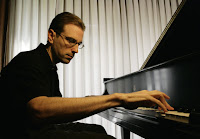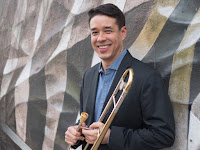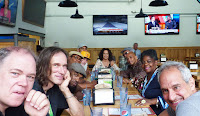Pianist-composer
Michele Rosewoman, born in Oakland, California, has been active on the contemporary music scene since the mid-1970s. After moving to New York City in 1978, she became even busier working in the bands of Jimmy Heath, Julius Hemphill, Billy Hart, Butch Morris, Oliver lake, and many others. Ms. Rosewoman also worked in Afro-Cuban and Afro-Caribbean bands led by Paquito D'Rivera, Celia Cruz, Román Diaz, and others. Her 1984 debut album, "
The Source" (Soul Note), featured trumpeter Bakaida Carroll and was in a more exploratory vein. Subsequent recordings introduced her
Quintessence band that's been in existence since 1986 and has featured over saxophonists Greg Osby, Miguel Zenon, Steve Wilson, Mark Shim, and Gary Thomas plus drummers Terri Lyne Carrington, Gene Jackson, and Cecil Brooks. At the same time, she began to work with a trio as well as with
New Yor-Uba, a larger ensemble inspired by the Yoruba tribe of Nigeria, Benin, and Togo.

To celebrate the 35th anniversary (!) of New Yor-Uba, Ms. Rosewoman has recorded and released "
Hallowed (featuring "Oru de Oro")" (Advanced Disques Music). The program spotlight her 10-movement rhythmic suite "
Oru de Oro" (roughly translated as "
room of gold") that features the 10-member ensemble plus percussionist
Román Diaz taking sacred rhythms and beats from the study of
Yoruba deities. The leader's arrangements keep the focus on the various drums while leaving room for her colorful horn voicing and powerful piano work. Each song is dedicated to a different diety (often more than one) – still the music allows in all listeners to follow the melodies and ride the waves provided by the rhythm section. Quite notable is the work of
Chris Washburne, most especially his amazing tuba work on "
Flowers That Bloom In The Dark." Check out his mighty trombone solo on "
Mountain Sky, Healthy High" as well as the strong solo of the leader. There is an delightful blend of saxophone and brass on "
Forest of Secrets" that opens to a splendid flute spot from
Román Filiú and a short trumpet solo from
Alex Norris.

Percussionist Diaz's declamatory poem over Ms. Rosewoman's sweet Fender Rhodes and bassist
Gregg August's fine bass work leads the listener into "
The World is The First To Know", the first of the two tracks that close the album (but are not part of the suite). Vocalist
Nina Rodriguez shows up 1/3rd of the way into the track, singing sweetly over the Rhodes before breaking into a "folkloric" chant over hand drums and joined by a chorus of Ms. Rosewoman, Mr. Diaz, and percussionist Mauricio Herrera. When the ensemble reenters, there are powerful solos from saxophonists Filiú and Stacy Dillard as well as the leader. As the piano fades, the drums, Ms. Rodriguez, and chorus return to sing the band out.
"
Hallowed" closes with "
Alabanza", one final rhythmic treat that is not only the longest track on the album bot one that spotlights the solo work of many of the ensemble members. Halfway through the piece, the tempo changes, becoming more energetic and, if possible, even more exciting (
Robby Ameen's drum solo absolutely shakes the walls). The vitality of the music, the splendid instrumental work, the continuous drums, and more, illustrates that
Michele Rosewoman's New Yor-Uba is quite a force to be reckoned with. Don't be surprised if you just want to get and dance.
For more information, go to
www.michelerosewoman.com.
Give a good listen:
Personnel:
Alex Norris--trumpet, flugel horn
Román Filiú--alto & soprano saxophones, flute
Stacy Dillard--tenor saxophone
Chris Washburne--trombone, bass trombone, tuba
Andrew Gutauskas--baritone saxophone (on the final two tracks)
Michele Rosewoman--piano, fender rhodes, vocals
Gregg August--bass
Robby Ameen--drums
Román Diaz--batá, congas, vocals
Mauricio Herrera--batá, congas, vocals
Rafael Monteagudo--batá, congas
Nina Rodríguez--lead vocals (on "The Wind Is the First To Know")
Saxophonist and composer
Joel Miller first came to critical notice in1997 when he won the
Grand Prix of the Montreal International Jazz Festival. That was also the year he released his debut album. Since then, he's released a dozen or so albums as a leader and/or co-leader, married composer and bandleader Christine Jensen, traveled all around the world, performing music that touches so many different genres and styles. And Miller is a avid listener therefore he has no fear of putting different elements into his music.
"
Unstoppable" (Multiple Chord Music) is his latest and features a unique large ensemble. The 15-member group features 2 flutists, three clarinetists plus a bass clarinet player, two saxophonists, two trumpets, a horn player, a percussion, and rhythm section of piano, guitar, bass, and drums. Five of the 14 tracks feature an additional percussionists (three of those tracks add one more percussionist). The program, all composed and arranged by Miller, features three suites plus one stand-alone piece "
Dance of the Nude Fishes", a rocking, good-time, tune that makes one want to dance all over the house. First suite is "
Song Story", a three-movement work whose opening section "
Gyre" leans towards a mix of Aaron Copland, Maria Schneider, and Miller's wife Ms. Jensen (who leads an award-winning orchestra in Canada). Percussionist
Erin Donovan adds vibraphone which often shadows
David Ryshpan's piano. Part 2, "
A Party", opens like a flat-out rocker a la Abba with a lovely coda at the end of each playing of the theme. Miller's gutsy, gusty, tenor sax solo blasts out over the band – the piece picks up speed and the reeds and brass blow short phrases at each other. Miller turns to soprano sax for a solo over a rubato rhythm and near the close of the movement, the plays alongside him. Part 3, "
A Change of Scenery", opens as a soulful ballad that, at ties, reminds this listener of Procol Harum's "
A Whiter Shade of Pale", itself a mixture of JS Bach and Stax/Volt. Miller's tenor solo has great emotion and power and leads the band into a closing explosion a la Steve Reich. Really – that's what I hear.
The other two suites are just as engaging. The six-movement "
What You Can't Stop" has a dark opening section but that changes quickly as the music takes on a lighter mode led by flutes and glockenspiel. This piece also has a panoramic sound in the fashion of Copland's majestic suites of the 1930s and 40s. As the music moves forward, the piece changes for light to introspective to a brisk Latin beat (dig the cajón and cabasa) to a short, romp, led by the saxophones to a final movement that begins softly, layering the various voices and looking at previous thematic material before scurrying and slowing back down to a gentle close.
The third Suite, and the final four tracks on the CD, "
Deerhead Hoof Suite", opens with tolling guitar chords and a Americana-style melody from the brass. As the "Intro" rolls along, it drops into a "rock and roll" beat still with the trumpets taking the lead. "
2: Pachamama" opens as a handsome ballad; no one voice or section takes the lead as it is shared across the sound spectrum. Then, Miller's tenor sax steps out for the mix and into the spotlight. Listen to the different voices swirling around his lead. "
3: How Do You Breathe" has an appealing forward motion and several lyrical themes shared among the instrumental voices. As befitting the final movement, aptly titled "
Finale", the music has a dancing feel, steady 4/4 drums, and, once again, the brass voices stand out. Miller's tenor solo has a wild streak running through it leading to a handsome fade and a return to the tolling guitar sound.
"
Unstoppable" is a delightful look inside the creative mind of saxophonist
Joel Miller. While it rarely sounds like a "big band" album, his arrangements utilize the instrumentation in enchanting and, often, powerful ways. Sit back and soak in the sounds!!
For more information, go to
joelmillermusic.com.
Enjoy this "
Dance...":
Personnel:
Joel Miller - tenor & soprano saxophones, conductor
Billy Kerr - flute
Nadia Sparrow - flute
Mark Simmons - clarinet
Luc Jackman - clarinet
Jennifer Bell - bass clarinet
Bruno Lamarche - tenor saxophone & clarinet
Jocelyn Veilleux - horn
Lex French - trumpet
Bill Mahar - trumpet
David Ryshpan - piano
Erin Donovan - percussion
Steve Raegele - guitar
Fraser Hollins - bass
Kevin Warren - drums
Sacha Daoud - percussion (tracks 2, 4, 6, 7, 8, 9)
Kullak Viger Rojas - percussion (tracks 2, 7, 8)
Christine Jensen - guest conductor (tracks 1, 2, 3, 10)
Saxophonist, composer, and arranger
Chelsea McBride (a resident of Toronto, Ontario, Canada) made quite a delightful splash in 2017 with the release of the debut album of her
Socialist Night School large ensemble. The 19-member group is conversant in many different styles – they can rock, they can push forward a blues and caress a ballad, and the solos that rise out of the ensemble are often impressive. Vocalist
Alex Samaras has a supple voice, a tenor with a broad range but not a belter. When you mix that with the intelligent arrangements and how they frame his voice, it's an excellent listening experience.
The SNS's second album (it's debut recording in 2014 was an EP) is here; "
Aftermath" (self-released) is a panoply of sounds and moods filled with fine melodies, mostly held together by Samara's voice. Nine of the 10 tracks have lyrics and tells stories that deal with conflict, personal issues, reflection, and resolution. Opening with "
Revolution Blues", a song that takes a cynical look at street demonstrations and the commitment for change, one is introduced to a full sounding band. Powered by drummer
Geoff Bruce and the baritone sax of
Conrad Gluch, the piece has a kick but also a softer side plus a fine tenor sax-trombone dialogue between the leader and
Aidan Sibley. "
Say You Love Me" is about commitment as well, one that has dissipated into lies and broken hearts. One of the more powerful lines is "
I thought I'd be hurt forever/But I turned you into art." Alison Young creates a heart-wrenching solo, filled with cries and screams.
 |
| Image: YouTube |
When you pay attention, it's easy to be caught into the twin webs of the lyrics and the music. "
House on Fire" speaks to the rape of the world's natural resources ("
I can take your dirt and make it gold/ Turn your trees to goods that can be sold") while the music refers to Blood, Sweat, and Tears bouncy lines on "And When I Die." Gluch and Bruce are again quite impressive but the time both get to solo. The high-energy "Fly By Night" begins with a short solo from guitarist David Riddel before Samaras tells the story living by his wits and his fists. "Niagara" is a love song about a person so much in love that he/she cannot live alone and wishes to be covered with the waters from the famous Falls. The performance is a vocal tour-de-force yet pay attention to the different sections layered around the voice.
The final two tracks begin with the bluesy, sassy, "
Porcelain", a swinger that could easily move into Michael Buble's repertoire. Again, it's the baritone that leads the arrangement giving the saxophones plenty of space to swing.
Naomi Higgins and
Colleen Allen step to the fore with their alto sax interactions – the rhythm section picks up the power and they respond in kind. The album moves out on "
Love Is On The Line", a quiet ballad that speaks to a relationship that could either way. The narrator is looking for commitment and is willing to stay but "
All I want to know is: Will you stay? ,,,,,,All I have to say/ All my love is on the line." There's a lovely trombone solo from William Carn and fine acoustic guitar work by Riddel but the finest moments belong to Samaras's voice and the fine arrangement in the final minute.
Chelsea McBride's Socialist Night School makes music that involves the listener, making one pay attention to the words, the solos, and the arrangements; this is not background music. You can hum along with some tunes, see yourself in the stories the leader creates, and appreciate the musicianship as well as the fine vocal work of
Alex Samaras. Take your time in entering into this sonic world – give it your mind and your soul and you will be richly rewarded.
For more information, go to
crymmusic.com/projects/socialistnightschool/.
Here's the opening track:
Personnel:
Chelsea McBride – tenor sax, conductor, composer
Colleen Allen – soprano and alto saxophones, piccolo, flute, alto flute
Naomi Higgins – soprano and alto saxophones, flute, alto flute
Alison Young – tenor saxophone, flute, clarinet
Patrick Smith – tenor and soprano saxophones, flute, clarinet
Conrad Gluch – baritone saxophone, bass clarinet, contrabass clarinet, alto flute
James Rhodes, Justin See, Tom Upjohn, Kaelin Murphy – trumpets/flugelhorns
William Carn, Aidan Sibley, Jill Richards – trombones
Nicholas Sieber – bass trombone, tuba
Alex Samaras – voice
Chris Bruder – piano
David Riddel – guitar
Steven Falk – acoustic and electric basses
Geoff Bruce – drums
 |
| Nonet 2019 |
Alto saxophonist
Lee Konitz (born 1927) first encountered
Ohad Talmor (1970) in Switzerland in 1990; the young saxophonist, composer, and arranger began to work with Konitz three years later. After the younger man moved to New York City in 1995, he began a relationship that continues to this day. In 2002, with the aid of bass clarinetist
Denis Lee, Konitz and Talmor revived the elder musician's nonet. Along the way, Talmor arranged an album that appeared on OmniTone Records in 2006 but also two albums with two different string quartets (Palmetto and OmniTone) and with a big band (also on OmniTone from 2007).
Sunnyside Records is the home for the new
Lee Konitz Nonet album "
Old Songs New" – Talmor organized a group that has no brass instruments but features a string trio (violist
Judith Insell plus cellists
Mariel Roberts and
Dimos Goudarolis) plus a reed section composed on
Caroline Davis (flutes),
Christof Knoche (clarinet), and the afore-mentioned bass clarinetist Lee. Bassist
Christopher Tordini and drummer
George Schuller (who also helped with the mixing and editing) round out the ensemble. The program features seven standards plus two Konitz originals "
Kary's Trance" and "
Trio Blues." The former track, first recorded in 1956 by Konitz in a quartet setting, is a delightful swing piece with a handsome solo from the leader and an excellent arrangement. The latter track, the final cut on the album, is what the title intimates, a tune for Konitz and the rhythm section to "blow"over. All three players solo but nothing is hurried and the music unfurls in a delightful fashion from beginning to end.
 |
| Image: YouTube |
The bulk of the material are "standards", many of which the a lot saxophonist has played over six decades. They range from the moody "
Goodbye" (Gordon Jenkins) to the lovely ballad "
In The Wee Small Hours of the Morning" to the introspective "
You Go To My Head". Each track stands out for the way the arrangements add multiple colors, some times echoing the melody, other times providing counterpoint. The lightness of the alto is matched by the gentle flute and clarinets while the strings provide depth to the atmosphere. There are moments in Konitz's solos (such as "
...My Head" and "
I Cover The Waterfront") when one can really hear him relishing the melody and having a delightful time playing. Note the delight in the spicy arrangement of "
This Is Always" (composed by Harry Warren and Mack Gordon) plus the bluesy solo from Konitz.
Considering he had turned 90 the week before the 2017 recording,
Lee Konitz sounds fine throughout "
Old Songs New". Even though these are works that he had played many times, his improvisations are a delight, displaying wit, wisdom, and a playful quality that brings a smile to the listener's face. Be sure to listen to the fine, creative, arrangements of
Ohad Talmor who must revel in the joy of placing his friend in such musical settings. Sit back, relax, and soak in the sounds.
For more information, go to
ohadtalmor.com.
Enjoy this slice:
Personnel:
Lee Konitz - alto saxophone
Ohad Talmor - arranger, conductor, tenor saxophone on "I Cover The Waterfront")
Caroline Davis - flute & alto flute
Christof Knoche - clarinet
Denis Lee - bass clarinet
Judith Insell - viola
Mariel Roberts - cello
Dimos Goudaroulis - cello
Christopher Tordini - bass
George Schuller - drums






















































